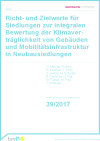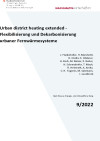Suchergebnisse
Solar Assisted Heating Networks
An investigation of the economic and ecological usefulness of coupling two CO2 neutral energy sources; solar installations for multi-family houses, producing standardised systems concepts and planning guidelines.
Solar cooling machine with a cooling power of 2 kW

Development and building of a prototype of a coolingmachine with a cooling power of 2 kW, tests and optimizing on a test facility, connection to a solar unit and utilization for air conditioning.
Sorptionsgestütztes Kühl- und Entfeuchtungsgerät
Klimatisieren mit der Sonne in Kombination mit komfortabler kontrollierter Wohnraum-lüftung bald auch für Hausbauer möglich und erschwinglich. Mit Hilfe eines neuartigen Bauteils soll der DEC Klimatisierung zum Durchbruch verholfen werden.
Building of Tomorrow for the construction industry
Dissemination of results of the research initiative "Building of tomorrow" for two specific target groups - master builder and installer - implementation in further vocational training concepts
Richt- und Zielwerte für Siedlungen zur integralen Bewertung der Klimaverträglichkeit von Gebäuden und Mobilitätsinfrastruktur in Neubausiedlungen

Entwicklung und Abstimmung von Kennwerten für die energetische und ökologische Bewertung von Siedlungen auf Basis der Schweizer 2000-Watt-Arealzertifizierung. Die Ergebnisse bilden einen weiteren Baustein zum Aufbau eines Qualitätssicherungssystems für Siedlungen ähnlich der klimaaktiv Deklaration für Gebäude bzw. der e5 Zertifizierung für Gemeinden.
Schriftenreihe
39/2017
Herausgeber: BMVIT
Deutsch, 118 Seiten
Downloads zur Publikation
Sunny Energy Building: ENERGYbase - Bürohaus der Zukunft
Mit der Errichtung dieses zukunftsweisenden Kompetenzzentrums für Erneuerbare Energie setzt der Wiener Wirtschaftsförderungsfonds (WWFF) neue Maßstäbe bei der Entwicklung Energie optimierter Büroimmobilien. Auf 7.500 m² stehen Unternehmen sowie Forschungs- und Bildungseinrichtungen aus dem Zukunftsbereich der Erneuerbaren Energien modernste Büroflächen zur Verfügung.
DALEC - Day- and Artificial Light with Energy Calculation
Entwicklung eines Online-Konzeptanalysetool für ArchitektInnen, BauingenieurInnen, LichtplanerInnen und Bauherrn, welches trotz einer einfachen Handhabung und kurzen Berechnungszeiten, die komplexen lichttechnischen und thermischen Vorgänge in einem Gebäude abbildet und Heiz-, Kühl- und Kunstlichtbedarf anschaulich bewertet. Zudem wurde das Nutzerverhalten (z.B. Blendschutz) berücksichtigt und visuelle und thermische Komfortkriterien analysiert. Diese neuartige und innovative, gesamtheitliche Betrachtung ermöglicht eine nachhaltige und energieeffiziente Entwurfsplanung für Neubau und Sanierung.
Regelungstechnik für die Hausheizung der Zukunft

Durch Optimierung der Regelung von Biomassefeuerungen können Schadstoffemissionen und Energieverluste erheblich reduziert werden. Ziel der Projekts ist daher zunächst die Analyse derartiger Einsparungsmöglichkeiten anhand des zeitlichen Verlaufs des Wärmebedarfs verschiedener "Häuser der Zukunft". Aufgrund der Ergebnisse dieser Analyse wird ein optimiertes Regelungssystem entwickelt und anhand einer Biomassefeuerung erprobt.
Innovative regulation of thermal solar collectors
Research and development of the possibility of a "sensorless" regulation for thermal solar systems
ProKlim - Prognosegesteuerte Gebäudeklimatisierung
Energieeffizienzsteigerung in der automatisierten Gebäudeklimatisierung durch wetterprognoseunterstützte Regelung
e80^3-Buildings - Sub project 2: Concept development
Based on the selection of suitable demonstration projects in Subproject 1 an innovative concept for passive and active building envelopes and energy supply of so called "Plus Energy Buildings" (renovation) has been developed.
DALEC - Day- and Artificial Light with Energy Calculation
In the course of DALEC an online concept evaluation tool for architects, building engineers, lighting designers and building owners was developed. Although easy to use, the software accounts for the complex thermal and light processes in buildings and allows a simple evaluation of heating, cooling and electric lighting loads. Not only energy, but also user behavior were considered (e.g. in terms of glare protection) and visual and thermal comfort were evaluated. This novel and innovative, holistic approach makes sustainable and energy efficient building design possible for new buildings as well as refurbishment.
Urban district heating extended - Flexibilisierung und Dekarbonisierung urbaner Fernwärmesysteme

Entwicklung innovativer urbaner Fernwärmeversorgungssysteme durch Integration von Langzeitwärmespeicher, (Groß-)Wärmepumpe, solarthermische Großanlage, Abwärme und simulationstechnischer Analyse und Bewertung. Das Ergebnis dient als Vorbild für Technologieauswahl und Einsatzreihenfolge neuer urbaner Fernwärmeversorgungsgebiete.
Schriftenreihe
9/2022
J. Fladenhofer, H. Marchetti, H. Ondra, E. Höckner, H. Koch, M. Moser, P. Reiter, H. Schranzhofer, T. Mach, R. Heimrath, A. Arnitz, C. R. Tugores, M. Salzmann, I. Leusbrock
Herausgeber: BMK
Deutsch, 176 Seiten
Downloads zur Publikation
SQUARE - Qualitätssicherung in der Gebäudesanierung
Entwicklung eines systematischen, flexiblen Qualitätsmanagements für Sanierungsprozesse. Es soll zu qualitativ hochwertigen Sanierungen führen, die sich in verbesserter Energieeffizienz und einem verbesserten Wohnraumklima von Wohngebäuden zeigen.
Photovoltaic solar modules for building integration
Development of new manufacturing technique for photovoltaic solar modules, which fulfil the special requirements of building integration.
City Cooling - Intelligente Fernkälteversorgung Wien
Konzeptentwicklung für eine intelligente Fernkälteübergabe und alternative Rückkühlung von zentralen Groß-Absorptionskälteanlagen am Fallbeispiel des Wiener Stadtteils TownTown
Energiespeicher Beton: Thermische Bauteilaktivierung. Planungsleitfaden Einfamilien- und Reihenhäuser

Im Planungsleitfaden "Heizen und Kühlen mit Beton" werden die Erkenntnisse bisheriger Forschungsprojekte zur Bauteilaktivierung zusammengefasst, es wird gezeigt, wie Energie in massiven Bauteilen über längere Zeit gespeichert und zu beliebigen Zeitpunkten wieder abgerufen werden kann. Der Planungsleitfaden ist mit detaillierten Anleitungen auf die Bedürfnisse von Planenden und Bauausführenden sowie auf die Wissensvermittlung zur Aus- und Weiterbildung konzipiert.
Felix Friembichler, Simon Handler, Klaus Krec, Harald Kuster
Herausgeber: BMVIT
Deutsch, 122 Seiten
Downloads zur Publikation
Sunny Energy Building: ENERGYbase - Office building of tomorrow
Energybase is a showcase project in terms of energy efficiency and use of renewable energies realized by the Vienna business agency. With 7.500 sqm net floor area ENERGYbase provides space for innovative business and research and development on the field of green energy.
Gründerzeit with future - demonstration project 1: David´s Corner
High value energy efficient refurbishment of an ensemble of three neighbouring Wilhelminian style buildings in a non-lucrative location.
MODESTORE - Modular High Energy Density Sorption Heat Storage

Seasonal storage of solar heat for use in low energy and passive houses (new buildings as well as old buildings).
